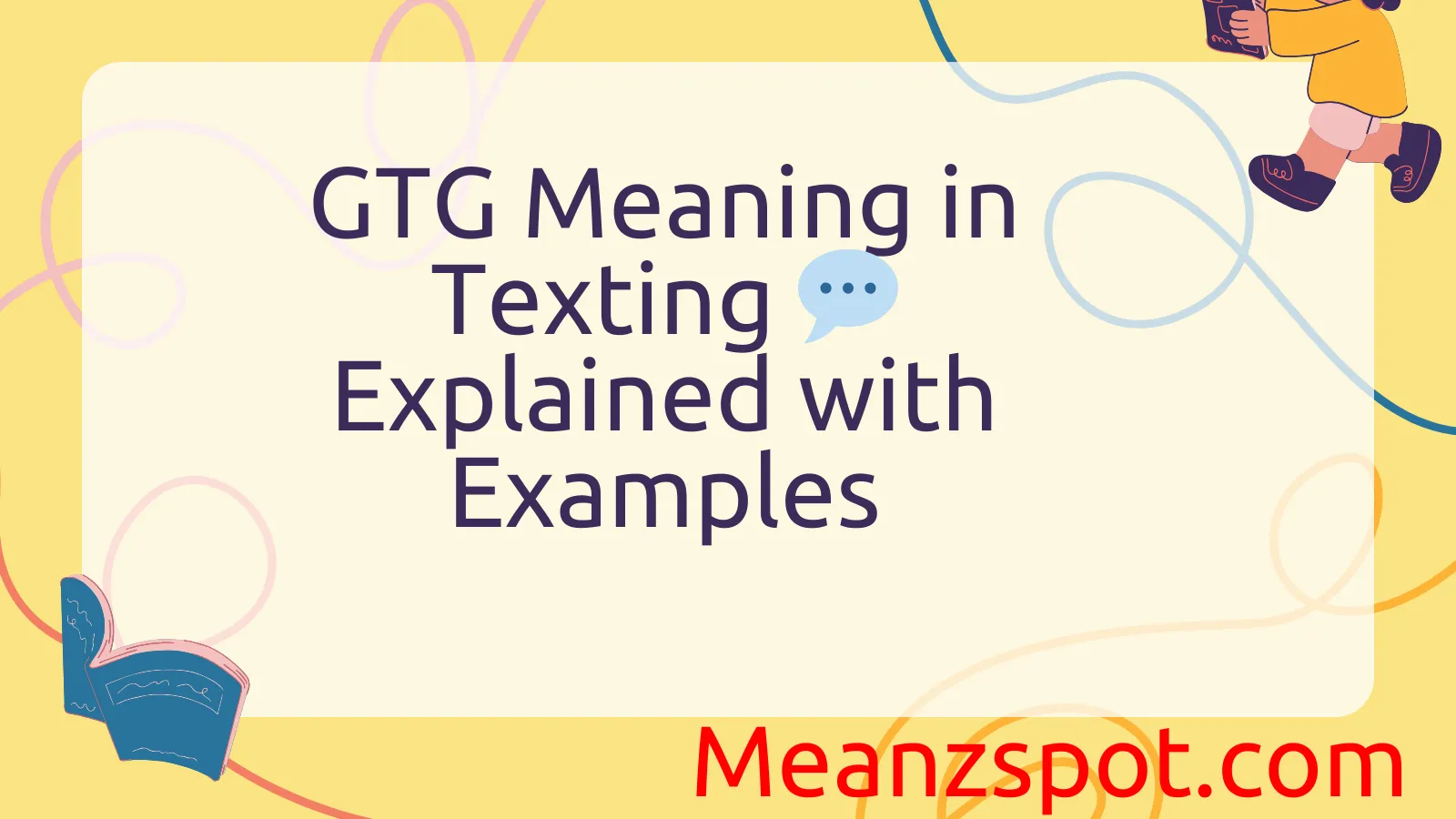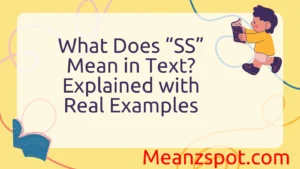Texting slang changes fast, and sometimes it feels like you need a dictionary just to keep up. One abbreviation you’ve probably seen a lot is GTG. But what does it mean, and how do people use it in everyday conversations?
In short, GTG stands for “Got To Go.” It’s a quick way to let someone know you’re about to leave or end a chat. Whether you’re wrapping up a text with a friend, signing off from an online game, or just busy with something else, GTG is the polite and speedy way to say goodbye.
In this guide, we’ll break down the meaning of GTG, where it came from, and share real-life examples so you’ll know exactly when and how to use it in your texts.
Definitions & Meaning
GTG stands for “Got to go” or “Good to go,” depending on the context in which it’s used. These meanings are situational and can be interpreted differently based on the surrounding conversation.
- Got to go: This is the most frequent interpretation of GTG. It’s used to let someone know you’re leaving a conversation or stepping away.
- Example: “Sorry, GTG! Talk later.”
- Good to go: In some contexts, GTG means everything is ready or approved.
- Example: “The files are uploaded—we’re GTG.”
GTG is considered informal and is commonly used in texting, instant messaging, gaming chats, and social media platforms. While it’s primarily used among friends, it can occasionally appear in casual work environments, especially in tech or creative fields where informal communication is more accepted.
The flexibility of GTG makes it a convenient shorthand, but it also requires readers to understand the context to interpret its meaning accurately. Tone, setting, and the relationship between the communicators usually help clarify which meaning is intended.
Origins & History
GTG originated as part of the broader evolution of internet slang in the late 1990s and early 2000s, when chat rooms, SMS texting, and instant messaging services like AOL Instant Messenger (AIM) and MSN Messenger became popular. These platforms had character limits or encouraged fast-paced communication, which led users to create abbreviations to save time and space.
Abbreviations like GTG became part of what’s now known as “text speak” or “internet shorthand.” They served the dual purpose of streamlining conversations and reflecting a sense of online culture and community.
As smartphones and mobile communication advanced, so did the usage of such acronyms. GTG was eventually adopted into everyday texting vocabulary and spread across newer platforms like WhatsApp, Facebook Messenger, Snapchat, and Discord. Its longevity can be attributed to its versatility and ease of use.
Even as autocorrect and voice-to-text features have made typing full sentences easier, many users continue to rely on familiar acronyms like GTG, which have become ingrained in digital culture.
Usage in Different Contexts
GTG may appear in various settings, and understanding its usage depends on the context:
1. Casual Text Messaging
In personal chats, GTG is frequently used to signal the end of a conversation or the need to step away.
- Example: “Dinner’s ready, GTG!”
2. Social Media
On platforms like Facebook or Twitter (now X), GTG may be used in comments or direct messages when someone is leaving or closing a thread.
- Example: “Loved chatting! GTG now, though. :)”
3. Online Gaming
Gamers often use GTG in chats or voice channels to let teammates know they are logging off.
- Example: “That was fun, but I GTG—school in the morning.”
4. Work & Professional Contexts
Although informal, GTG can occasionally be used in casual team channels or coworker conversations, especially in creative or tech industries.
- Example: “Project’s approved. We’re GTG!”
5. Pop Culture & Memes
GTG has even made appearances in memes or humorous posts where it’s playfully exaggerated or used for dramatic exits.
- Example (meme caption): “When the drama starts—GTG.”
Being aware of the platform and audience is key to using GTG appropriately. While it’s suitable for informal interactions, it’s best avoided in formal emails or with unfamiliar professional contacts.
Common Misunderstandings & Clarifications
Because GTG has more than one meaning, it’s easy to misunderstand it without context. Here are a few common confusions:
- GTG = Got to Go or Good to Go?
This is the most common point of confusion. Typically, “Got to go” is used when someone is leaving, while “Good to go” indicates readiness or approval. The key to interpreting it is the surrounding text. - Is GTG rude or abrupt?
GTG can seem abrupt if not accompanied by a polite sign-off. Saying “GTG, talk soon!” is friendlier than just “GTG.” - Does GTG mean you’re done talking for good?
No, it simply indicates a temporary departure. The conversation can always resume later. - Is GTG appropriate in formal communication?
Not usually. In professional settings, it’s better to say “I have to leave now” or “Everything is ready to proceed” instead of using GTG.
Understanding tone, context, and familiarity with the audience helps avoid misinterpretation of GTG and ensures smooth digital interactions.
Alternatives & Synonyms
If you want to mix things up or use alternatives depending on the formality of the situation, here are some common replacements for GTG:
Casual Alternatives
- BRB (Be right back)
- TTYL (Talk to you later)
- G2G (Another form of “Got to go”)
- Later or Laterz
- Peace out
Professional or Polite Alternatives
- “I have to step away.”
- “Let’s continue this later.”
- “Everything is ready on my end.”
- “We’re all set.”
These alternatives allow you to convey the same message as GTG while adjusting the tone based on the platform or audience.
Frequently Asked Questions (FAQ)
1. What does GTG mean in a text message?
GTG most commonly stands for “Got to go,” signaling that someone is leaving the conversation.
2. Can GTG also mean “Good to go”?
Yes, in some contexts, especially professional or task-related, GTG means “Good to go.”
3. Is GTG still commonly used today?
Yes, it remains a popular acronym, especially in texting and online chats.
4. Should I use GTG in a work email?
No, GTG is too informal for professional emails. Use a more polished alternative.
5. What’s the difference between GTG and G2G?
They mean the same thing—“Got to go.” G2G is just a stylistic variation.
6. Is GTG okay to use in group chats?
Yes, it’s commonly used in both one-on-one and group text conversations.
7. How can I politely use GTG without sounding abrupt?
Add a closing phrase like “Talk soon!” or “Catch you later!” to soften your exit.
Conclusion
GTG is a simple, versatile acronym that continues to thrive in digital communication. Whether you’re letting a friend know you’re stepping away or confirming that a task is ready, GTG offers a quick and efficient way to express yourself. Understanding its dual meanings—“Got to go” and “Good to go”—is essential for interpreting and using it correctly.
Though GTG is mostly informal, its use spans across social, gaming, and even some workplace contexts. Being mindful of your audience and setting ensures you use GTG appropriately without causing confusion. As with many internet acronyms, clarity and courtesy are key. So next time you see GTG in a text, you’ll know exactly what it means—and when to use it yourself.



